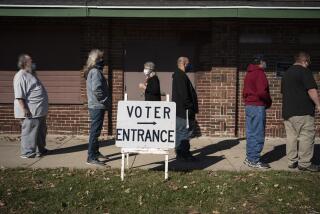Turning Back The Clock
- Share via
It may not be significant, but the Wisconsin upstarts who have ended the school’s 59-year absence from the Final Four bear a striking similarity to the Badgers who won the championship in 1941.
If this seems strange, considering the 59-year time frame, check out the words of Fritz Wegner, assistant coach of the 1941 title winners. Wegner was the late hall-of-famer Bud Foster’s trusted lieutenant until both retired in 1959.
“Our style was basically the same as this team’s today,” said Wegner, 88, who still lives near the campus in Madison. “We played good defense, with a lot of double- and triple-teaming.
“We were pretty good on offense too. We played as deliberately as they do now and, like them, we didn’t throw the ball away.”
Also like the current Badgers, Wisconsin’s title team didn’t set off fireworks on the scoreboard. In their three tournament games, the ’41 Badgers scored 51, 36 and 39 points, shooting 32%, 23% and 24%.
Why only three games? In that third year of the tournament, only eight teams were invited. There were Eastern and Western regionals, then the title game in Kansas City.
As it happened, the Eastern Regional was played in Madison, and the Badgers took full advantage of the noise generated by crowds of 12,500 and 14,000 at the old Wisconsin Field House. They squeaked past Dartmouth, 51-50, and eliminated Pittsburgh, 36-30--Pitt shot 19%--then went to Kansas City and beat Washington State, 39-34.
This wasn’t a deep Wisconsin team. The starting five carried the load.
The key men were All-American center Gene Englund, a 6-foot-4 senior from Kenosha, Wis., team captain and the Big Ten’s MVP, and All-Big Ten forward John Kotz, a 6-3 sophomore from Rhinelander, Wis., MVP of the championship game.
Other starters were Fred Rehm, a 6-2 sophomore guard from Milwaukee; Ted Strain, a 5-11 senior guard from Harvard, Ill., and Charlie Epperson, a 6-1 junior forward from Jackson, Mich.
“Everybody played a role,” Wegner said. “We had a team the year before that wasn’t very good. We went 3-9 in the Big Ten and 5-15 overall. But then Kotz came in and he along with Rehm gave us enough to send us way up to the top.
“Kotz . . . had a great one-handed shot, which was a novelty in those days. He had great hands and . . . a head-and-hand fake that would send a guy right off the floor.”
If the Badgers’ offense then resembled their current one for slowness of pace, it was notably different in one respect, consisting entirely of set plays.
Devised by Foster and Wegner, the plays were designed to give the Badgers easy shots. They didn’t always work, but when they did, they were almost unstoppable.
“Bud was one of the best pattern coaches,” Wegner said. “He had a variety of plays, with a lot of options, and he was awfully good at designing new ones.”
The 1940-41 Badgers finished their championship season with a 20-3 record, 11-1 in the Big Ten, and a 15-game winning streak. Remarkably, they beat every team they played. They lost to Pittsburgh, Marquette and Minnesota, but had beaten Marquette earlier and evened the score with Minnesota in the Big Ten finale and with Pitt in the tournament.
The defeat by Minnesota, a 44-27 nightmare, was generally cited as the turning point of the season.
“We didn’t score a field goal in the second half,” Wegner said. “But we had some time to work after that, and believe me, we really worked.”
Rehm, 78, said of the Minnesota debacle, “It was really weird. [The Gophers] knew our plays better than we did. Every time we would throw a pass on one of our plays, a Minnesota guy was there.”
Foster believed that the problem was far more serious than a one-game letdown. In “The Classic,” a 1979 book by Ken Rappoport, Foster said, “ . . . We seemed to have a little dissension. . . . Englund was a very strong offensive player and very determined, and he took a lot on himself, being a senior.”
The Badgers bounced back to beat Iowa, 49-35, then went undefeated the rest of the way.
Of the 10 subsequent Big Ten victories, the most meaningful was the ninth, a 38-30 conquest of Indiana’s defending NCAA champions on the Hoosiers’ home court.
“They were expected to repeat in the Big Ten and when we beat them, we knew we had a championship-caliber team,” Foster told Rappoport. “That really put us in great mental condition.”
After that, the Badgers avenged the Minnesota defeat with relative ease, 42-32, and turned to the tournament.
There were a few complaints about Wisconsin playing at home but since the Badgers had finished ninth in the Big Ten the previous season, the NCAA could hardly have had that situation in mind when the Eastern Regional was awarded to Wisconsin.
Dartmouth’s Ivy League representatives nearly toppled Wisconsin in the tournament opener, the 51-50 thriller. Dartmouth led at the half, 24-22, and Wisconsin had to rally late in the game to go ahead, 47-44. The score was 51-46 with a minute to play and a final flurry by Dartmouth fell a point short.
While the Badgers were wrapping things up in Madison, Wegner was in Kansas City for the Western Regional final, in which Washington State beat Arkansas, 64-53. With no TV in those days, scouting was done in person, and Wegner’s report played a key role in Wisconsin’s 39-34 victory in the championship game.
Washington State’s Paul Lindeman, who had scored 40 points in his two previous games, scored three free throws, period.
Wisconsin led at the half, 21-17, broke away from a 24-24 tie to a 30-24 lead, then coasted home.
After the game, the Badgers took turns carrying the trophy as they walked to their nearby hotel.
Wegner recalled in Rappoport’s book, “One of the guys said, ‘Let’s enjoy this, because it’ll be a long time before it happens again.’ You know, he was right.”
More to Read
Go beyond the scoreboard
Get the latest on L.A.'s teams in the daily Sports Report newsletter.
You may occasionally receive promotional content from the Los Angeles Times.










